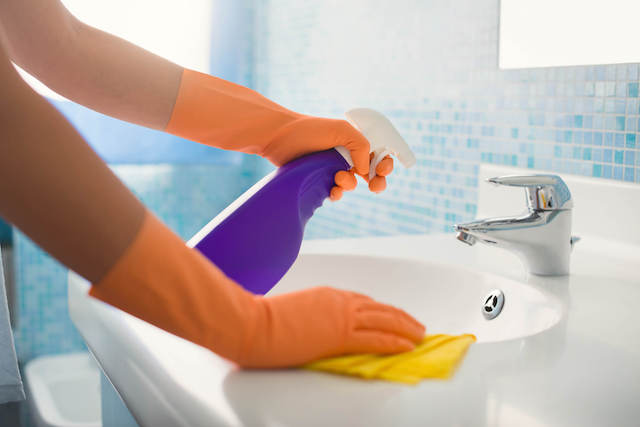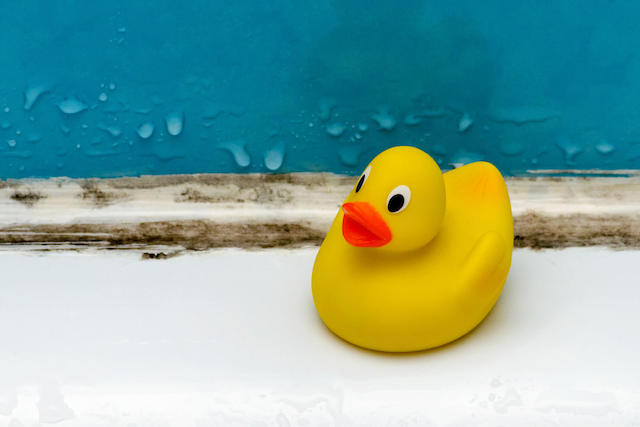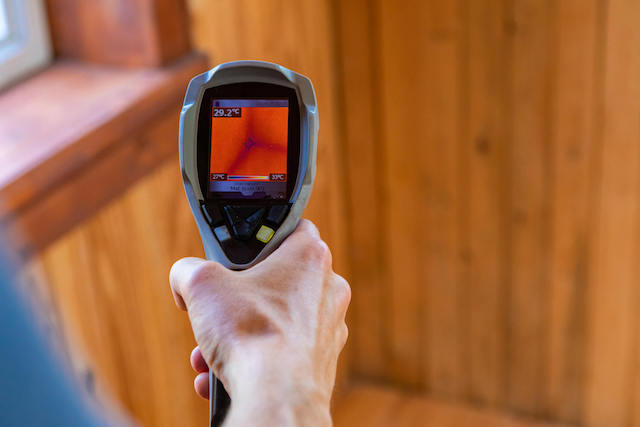Bathrooms are one of the most heavily trafficked areas in our homes. Think about it! These rooms are where we get ready for work, take time to relax in a nice bubble bath, brush our teeth before bed, etc., etc. All of this constant in-and-out movement combined with high levels of water use, though, means that these rooms have a tendency to get a little icky. And with ick often comes contamination situations, which puts a bit of a damper on our spa time. This inclination for these spaces to go to the dark side of home health is why it’s important to actively take steps to prevent mold in the bathroom.
Most of us have probably dealt with mold in the bathroom at least once. Whether in the bathtub, grout, showerhead, or toilet bowl, this room is at the top of the list for that fungus among us to pop up and begin growing. But that doesn’t mean that it’s a pattern we should allow to continue!
Avoiding contamination situations will help ensure that we’re not exposed to all sorts of microscopic particles like mold spores, mycotoxins, and bacteria every time we step into the bathroom. High levels of these particles can not only cause adverse health reactions but also lead to more microbial growth elsewhere in the home.
No one wants to hang out in an indoor environment bogged down by all of those contaminants, especially if you’re trying to relax and unwind after a long day at work.
To keep your home safe, here’s what you can do to prevent mold in the bathroom.
12 Steps to Prevent Mold in the Bathroom
1. Checking for leaks and/or addressing them quickly

Mold can grow in as little as 24-48 hours given a food and water source. Catching a water-related problem like a leak as soon as possible reduces the opportunity for mold to grow, which is why it’s at the top of the list of ways to prevent mold in the bathroom. Places to check are underneath the sink, the sink itself, the toilet, and around the shower and bathtub.
Any issue should be addressed quickly and correctly, and the space should be thoroughly decontaminated and dried out.
2. Creating airflow
Some species of mold can grow in high humidity, which is why indoor humidity levels should remain between 35–50%. Bathrooms are constantly flooded with moisture from the shower, sink, flushing toilet, and more, making it a top priority to keep the levels low in these spaces.
One way to achieve this is by creating better airflow. Turn on the exhaust fan while showering and crack a door or window. Also, leave the exhaust fan on for at least half an hour after showering to continue to ventilate the space. If this level just will not go down, consider investing in a dehumidifier for the space.
3. Checking the toilet tank
Mold in the toilet tank can be indicative of a larger mold problem elsewhere, like in a hidden location in the bathroom.
Why the toilet tank? When it comes to the tank, the lid is heavy, but it’s not hermetically sealed, meaning that it doesn't allow for much air exchange. If mold starts growing inside the tank, that typically means there are enough spores in the indoor air that some were opportunistically able to get into this location. While it’s not impossible for a spore to make it inside the toilet tank, it’s far more likely that a mold colony elsewhere is releasing high quantities of spores into the indoor air.
The sooner you catch a problem, the faster you can get started on resolving it. This helps lessen exposure and reduces the risk of another contamination situation developing elsewhere.
4. Deep cleaning regularly

Cleaning probably isn’t at the top of many people’s list of fun activities, but it’s a great way to help prevent mold in the bathroom.
Make sure to schedule in time to thoroughly clean the space once a week using a HEPA vacuum cleaner, botanical cleaning products, and microfiber towels. This reduces any particles present, such as mold spores, mycotoxins, bacteria, and organic matter that can be used for growth.
5. Cleaning grout and caulk with the right product
The tricky thing about grout and caulk is that they’re not non-porous and are more difficult to clean thoroughly.
Hydrogen peroxide is the best option because it can penetrate porous and semi-porous surfaces, bringing particles (like mold spores) up to the surface. From there, microfiber towels can be used to wipe the surface because they are 100 times better at removing tiny particles than regular rags. The ultimate goal is to remove as many particles as possible.
Schedule time to clean these surfaces often to reduce the opportunity for contaminants to move in.
6. Fixing any structural problems in the shower immediately
Misaligned tiles, cracks, bad grouting and caulking jobs, and aging grout and caulk can lead to built-up moisture problems. Any gaps or holes can let in water and trap organic particles, creating ideal conditions for mold growth.
To avoid this and help prevent mold in the bathroom, keep a close eye out for any structural issues and fix any you see ASAP.
7. Cleaning the showerhead

The last thing anyone wants to deal with is showering in moldy or bacteria-filled water. Unfortunately, these showerheads don’t always make it to the top of the cleaning list, meaning that this icky situation is probably occurring far more frequently than it should.
Mineral buildup combined with other organic particles floating around can turn these fixtures into a hazard. Deep cleaning it once a month (or more frequently if someone lives in a hard water area) can help keep the showerhead clean and healthy. Wiping it down daily with a microfiber towel is also a good idea.
8. Properly taking care of the toothbrush
These tooth cleaners (manual or electric) can become homes for mold and bacteria if proper steps are not taken to maintain them.
- Store manual toothbrushes in a bottomless holder
- Rinse them thoroughly after use
- Tap them on the counter after use to remove as much moisture as possible
- Make sure they get enough airflow to dry out properly
- Clean them once a week
- Replace them on time
9. Hanging up towels, bath mats, wash rags, and loofas to dry thoroughly
After use, hang up towels, washrags, loofahs, and bathmats so that they can dry out properly after use. This will help ensure they don’t remain wet for long periods of time. Again, reducing moisture is key to helping prevent mold in the bathroom.
10 Washing towels, bath mats, wash rags, shower curtains, and shower liners with a botanical laundry additive

It’s impossible to completely prevent mold spores, mycotoxins, and bacteria from entering the home. That’s okay! The goal is to continually work to remove any that snuck inside so that they don’t continue to build up, increasing the chances of a contamination situation developing.
Botanical products with surfactants will help pull small particles like mold spores from porous surfaces, reducing the opportunity for mold to grow on items like bath mats. Otherwise, they’ll continue to build up and increase the risk of microbial growth.
11. Separating the shower curtain and liner after use
The shower curtain and liner have a tendency to get moldy thanks to their constant contact with moisture. That’s why they’re at the top of the list for items to maintain to prevent mold in the bathroom.
After showering, the shower liner should be placed inside the tub and the shower curtain outside the tub so that both materials can dry properly. Separating them helps prevent moisture from getting trapped between them. Trapped moisture can allow mold to grow.
12. Not using makeup products in the bathroom
Is that black speck on your beauty blender mascara… or is it mold? That’s a scary thought, right?! No one wants to dab mold on their face.
The ingredients within beauty products offer various edible options for mold, as well as some of the elements of applicators, like glue. If moisture is added to the equation, there’s an opportunity for mold and bacteria to grow on these products. As bathrooms are high-moisture areas, it’s best to keep them far away from these spaces so that makeup products do not remain wet unnecessarily and allow for microbial growth.
Check out this blog post for more steps on keeping your makeup products safe.
Still Got Mold?
Mold is persistent and tricky. Even with all of the prevention in the world, sometimes it still manages to just pop up. That’s okay! The ticket to dealing with that fungus among us and ensuring it’s not tainting your indoor space is to handle it quickly and correctly.

To properly remediate mold, you’ve got to tick off three boxes.
- Remediate the sources properly.
- Identify and address the problems that led to those sources in the first place.
- Eradicate all contamination created by those sources, including spores, toxins, roots, fragments, and bacteria
Failure to hit every point is can lead to unsuccessful remediation.
If the source that led to the contamination isn’t addressed, the conditions for growth are still there, allowing the problem to come right back. Should the roots of the microbial growth be left behind, the colony can come right back. High levels of contaminants like mycotoxins and bacteria left behind can lead to continued exposure.
So! With that in mind, here are the steps to take.
Small Issues:
The rule of thumb is to only personally handle contamination situations under 10 square feet, but it depends on the situation. If mold is growing in an area like the bathroom ceiling, that can be a tricky issue. Porous materials like drywall and insulation need to be removed and replaced because it’s impossible to get all of the contamination off of the surface.
Not to mention, it’s difficult to determine the extent of the contamination situation. How deep does the contamination go?
Keep in mind as well that the issue that led to the opportunity should also be resolved, or else the mold can come right back.
The first step is to determine the type of surface that the growth is on. The process will vary based on the surface type in question.
The three surface types include:
- Porous: liquid absorbs into them, such as rags, towels, clothing, and carpet
- Non-porous: liquid pools on top of them, such as finished wood, sealed countertops, and glass
- Semi-porous: some liquid pools on top
For mold on nonporous surfaces like metal, and the issue that led to the growth is resolved, you can remediate it by using a botanical cleaner like Benefect Decon 30. Spray this on the surface, and then allow it to sit for 10 minutes. After this dwell time, wipe the surface with a microfiber cloth. These cloths are 100 times better at removing small particles. Repeat the process two times, allowing the cleaning product to sit for 30 seconds to ensure mycotoxins and bacteria, which are often found alongside mold colonies, are removed. These are particularly difficult to remove from a surface, which is why a thorough process is required. Use a different side of the microfiber cloth with each wipe, and then throw it away after use.
For mold on semi-porous surfaces, such as hardwood, the area needs an abrasive technique to remove the roots, as these can grow into the surface and be difficult to remove. Small particles like mycotoxins could have also burrowed within the fibers of the surface. From there, a thorough remediation process can be used to eliminate the particles present, and then the surface should be sealed. This comprehensive process is necessary because the mold can grow right back if the roots are left behind. On the other hand, exposure will continue if contaminants are still present.
As the EPA states, even dead mold can trigger adverse health reactions.²² That’s why bleach should never be used to get rid of black mold.
For porous items like the bath mat, it’s best to throw them away and start fresh with a new item to ensure all of the contamination is removed. The fibrous nature of the item makes it incredibly difficult to successfully remediate microbial growth.
Keep in mind that when you’re remediating the surface, particles will become airborne during the removal process Setting up proper engineering controls, wearing personal protective equipment, and creating a containment area should be included to help protect you and your home from the particle party.
After remediation, deep clean the surrounding area to remove any spores and mycotoxins that were released while the microbial growth was active.
Larger Issues:
Hire a Mold Inspector

The first step should be to hire a qualified mold inspector. This individual sets the foundation for success in properly handling a contamination situation. All of the data they collect will help create the comprehensive protocol needed by the remediation team to appropriately handle the problem. Not all mold inspectors are created equal, so make sure you choose the right person.
The chosen individual should spend at least a few hours combing through the interior and exterior of the home using a variety of methodologies.
Some of the testing data you should expect to see is:
- Species of mold present
- Quantities of each mold
- Potential spore presence in the HVAC system
- Presence of mycotoxins
- Presence of bacteria
All of this information is needed to understand what’s actually existing in the home so that they can create the right protocol for the unique situation. If other contaminants such as mycotoxins and bacteria are present, the remediation protocol will need to address this. Should spores make their way into the HVAC, this will need to be remedied. Otherwise, those particles will blow all over the home and could turn into a new mold colony.
For a list of qualified professionals, click here.
Bring in a Remediation Team
From there, a qualified remediation company should be brought in to deal with the issue. Keep in mind that not all remediation teams are built the same, though. The remediation company chosen should prioritize the health of the clients above all else. They should also have proven experience successfully dealing with toxic environments so that their clients can return home to heal. At the end of the day, that is the ultimate goal.
Their protocol should also tick off each of the three boxes listed above to successfully handle the situation.
Keeping The Ick Out of Your Home By Working to Prevent Mold in the Bathroom

Creating a healthy home takes time and effort, but it’s absolutely worth it! When the average person spends 90% of their time indoors and breathes 20,000 breaths per day, the state of these spaces matters. If they’re filled with all sorts of harmful toxins, that means you’re breathing in particles every time you step in the door.
Actively working to prevent mold in the bathroom is one key piece of the puzzle in maintaining an indoor environment that supports your wellness. As a high-moisture area, these spaces are on the front lines for developing contamination situations. The more you can do to keep these rooms clean and mold-free, the healthier they will be so that you can enjoy your spa time.
Health begins at home.™

